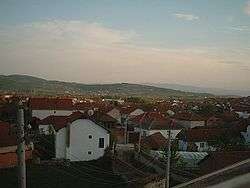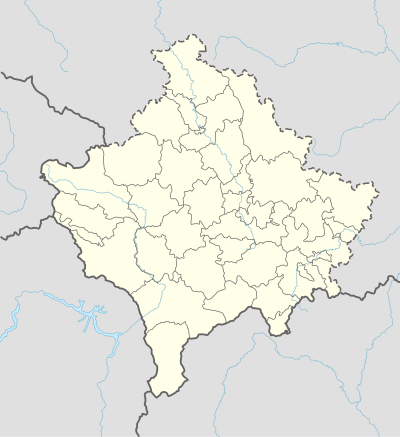Prilepnica
Prilepnica (Serbian Cyrillic: Прилепница) or Përlepnica (Albanian: Përlepnicë), is a village in the Kosovo Pomoravlje region of eastern Kosovo. The village is situated by the old mountainous road leading up to Novo Brdo, some 7 km from Gjilan.
Prilepnica | |
|---|---|
 Prilepnica | |
 Prilepnica Location in Kosovo | |
| Coordinates: 42°30′46.01″N 21°31′9.01″E | |
| Location | |
| District | Gjilan |
| Municipality | Gjilan |
| Population (2011) | |
| • Total | 1,944[1] |
| Time zone | UTC+1 (CET) |
History
The village was inhabited in the Middle Ages.[2] There are ruins of an old church.[3] Prince Lazar of Serbia (r. 1373–1389) was born in Prilepac near Boževce, which according to tradition was Prilepnica.[4] The village was mentioned in the Ottoman defter of 1455 of the Vlk Vilayet (Vilayet of Vuk), encompassing most of Vuk Branković's former territory. At that time the village was populated exclusively by Serbs, on the forehead with priest, living in 62 households.[5]
The village is mentioned under the name Prilěpnica (Cyrillic: Прилѣпница).
During the Kosovo War, on 6 April 1999, Yugoslav forces entered the village and ordered the population to leave, in order to set up mines. On 13 April, they were again asked to evacuate, and the next day, houses were set on fire.[6] A Serb was murdered on the Prilepnica road on 28 August.[7]
Some old walls were found at the time a dam was built, but archaeologists have not yet studied the site. In old houses and during construction of new houses, items such as ancient bottles and swords are often found. Although the objects remain unidentified, some have been kept as possibly valuable.[8]
Anthropology
Albanian families include: Kalaushi, Shabani, Muja, Zubaku, Hima, Syla, Tefiqi, Dankaj, Emini, Rexhepi, and others. These families settled from the Sanjak of Niš during and after the Serbian–Ottoman War (1876–78).[9]
See also
- Prilepnica (river)
- Prilepnica Lake
Notes
- Kosovo is the subject of a territorial dispute between the Republic of Kosovo and the Republic of Serbia. The Republic of Kosovo unilaterally declared independence on 17 February 2008, but Serbia continues to claim it as part of its own sovereign territory. The two governments began to normalise relations in 2013, as part of the 2013 Brussels Agreement. Kosovo is currently recognized as an independent state by 97 out of the 193 United Nations member states. In total, 112 UN member states recognized Kosovo at some point, of which 15 later withdrew their recognition.
References
- Kosovo census 1948 - 2011 Retrieved 20.05.2016.
- Hamid Hadžibegić, Adem Handžić and Ešref Kovačević (1972). Oblast Brankovića – Opširni katastarski popis iz 1455. Sarajevo, Socialist Federal Republic of Yugoslavia: Orijentalni institut Sarajevo.CS1 maint: uses authors parameter (link)
- Gojko Subotić (1998). Art of Kosovo: the sacred land. Monacelli Press. p. 248. ISBN 978-1-58093-006-2.
- Mirjana Đekić (1989). Srpska narodna nošnja Kosova: Gnjilane. Kulturno-prosvjetni sabor Hrvatske. p. 41.
- Hamid Hadžibegić, Adem Handžić and Ešref Kovačević (1972). Oblast Brankovića – Opširni katastarski popis iz 1455. Sarajevo, Socialist Federal Republic of Yugoslavia: Orijentalni institut Sarajevo.CS1 maint: uses authors parameter (link)
- United Nations Publications (2002). Yearbook of the International Criminal Tribunal for the Former Yugoslavia (F). United Nations Publications. pp. 107–. ISBN 978-92-1-156706-9.
- Zoran Andjelković; Center for Peace and Tolerance (2000). Days of terror: in the presence of the international forces. Center for peace and tolerance. p. 225.
- ^Hamid Hadžibegić, Adem Handžić and Ešref Kovačević (1972). Oblast Brankovića – Opširni katastarski popis iz 1455. Sarajevo, Socialist Federal Republic of Yugoslavia: Orijentalni institut Sarajevo
- Dr.Jusuf Osmani, Vendbanimet e Kosovës 6,Gjilani. page 148. Libri Shkollor, ISBN 9951-8547-5-3, Prishtinë 2004